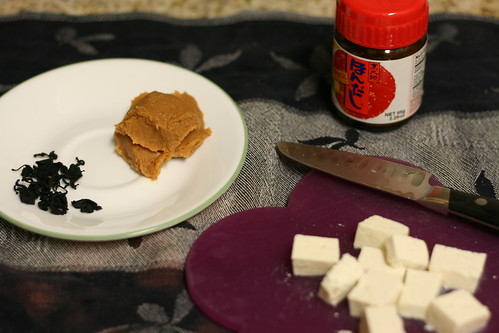
- Miso paste. Unless you live near an Asian market or a well stocked organic foods store (e.g. Trader Joe's or Whole Foods), miso paste can be difficult to find. Miso paste is available for ordering online
, but because the product is perishable it must be shipped overnight.
- Fresh Japanese style tofu. Chinese tofu doesn't taste "right" to me in miso soup, but if that's what you prefer then go for it. Use "firm" or "extra firm" tofu. Some of the freeze dried tofu can work in a pinch, but fresh is much better. Fresh tofu seems to be pretty widely available in the United States. Some tofu I've bought in the Midwest has an "off" flavor to me; YMMV.
- Wakame seaweed. This comes dried in plastic bags and is marked in English as "WAKAME SEAWEED." If you go to the really ethnic place you might need to look at the English language sticker placed by the importer on the back of the bag. You can buy online
if there's no Asian grocery nearby and you don't mind paying the outrageous prices. A little dab will do you -- a tiny shriveled piece expands in water to about five times in size. Just add three or four pieces per serving.
Wakame isn't strictly necessary, but it's nice to have for texture and traditional miso generally uses it. Other dried seaweeds can also be used. Just don't use nori (sushi seaweed). - Dashi. Dashi is the dead fish broth that gives Japanese food its distinctive flavor. I and pretty much the entire population of Japan use instant Hon Dashi
which is in the red capped jar in the above photo. Many American object to the MSG content of instant dashi, however (it's the number 2 ingredient, right behind salt), so you can also roll your own the old fashioned way by boiling kombu (kelp)
and moldy sardines
like my grandmother used to do, and get your monosodium glutamate the all natural way.
My hands down favorite soup stock for miso soup was when my grandmother boiled up a mess of clams in her kitchen and used the juice for the soup. That was wonderful. For the vegans, another soup stock I really like comes from simmering dried shiitake mushrooms.
Optional ingredients might include chopped scallions (green onion), chopped mushrooms, different kinds of seaweeds, and even meat, fish and shellfish chunks.
To make miso soup, start some water (or your homemade dashi stock) simmering in a sauce pan and add cubed tofu, wakame seaweed and instant dashi - I use a scant 1 tsp of powdered dash for 2 cups of water. Add the other optional ingredients such as vegetables and meats, but reserve the miso paste for last.
After the soup is heated through and the dried ingredients are reconstituted (2 or 3 minutes), remove from heat and stir the miso paste in -- about 1 Tablespoon for each 2 cups of water. Miso paste is added last because the delicate flavor can dissipate with prolonged exposure to heat. Serve the soup as soon as the paste has dissolved.
Miso soup is so simple to make I don't know why instant miso soup
4 comments:
=v= When I lived in the Midwest, Wildwood (of Fairfax, California) merged with a company that had farms in Iowa. As is often the case when something grows so large, quality is not as good in the days when it was a small, local product -- but it has brought improved tofu to more people, especially in the Midwest.
@Jym: You lived in the Midwest? Where and when?
=v= Omaha, 2002-2003, roughly coinciding with the start of Omaha Critical Mass and a battle to get a bike route that bridged a racial divide.
@Jym: Omaha was the place I lived where I experienced overt racial harassment. This was during the height of our involvement in Vietnam, and the hatred directed at me because of my oriental appearance when I was six years old was pretty intense.
Post a Comment